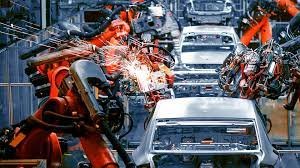The long-term growth story of the Indian automotive industry is strong, but short-term volatility is creating an environment of uncertainty. Most global OEMs view India as a strategic market of the future, and as a result, competition is intensifying. Bolstered by a dynamic industry environment, now is the time for India’s automotive supply chain to evolve to world-class performance levels. C-suite executives expect their supply chains to be a source of competitive advantage, which means going beyond meeting basic standards of performance such as connecting supply to demand at optimal costs.
Upamanyu Borah
The Indian auto industry is at the forefront of needing immediate supply chain transformation. That’s especially the case when considering change that historically has taken 10 years have now started to occur in a matter of months because of COVID-19.
To further complicate things, there’s foggy visibility across supply chains. That haze stems from poor real-time integration between various data sources, both within and between companies. Basically, for the auto industry, too many parts being sourced from too many countries means too much risk. But, what had been working is now broken.
This new environment has levelled the playing field and created new opportunities for Indian automakers to differentiate themselves through improved supply chain management. They are faced with a unique opportunity to improve revenue while reducing costs and improving asset throughput.
Recurring Problems and How to Fix Them?
To take advantage of this ‘New Normal’ environment, the country’s automotive supply chains should renew their focus on strategies in the following areas:
Accelerate collaboration across the value chain: While the automotive industry already has high levels of collaboration across the value chain, it is time to evolve to the next level. OEMs will need to lead efforts to achieve common goals and develop long-term win-win partnerships with other stakeholders. Enhanced collaboration will be required in three areas: improved supply planning across multiple horizons to address volatility, increased leverage of OEM-supplier strategic relationships to improve time to market and faster product scale-up, and evolved OEM-supplier partnership models to optimise inventory and throughput.
Innovate in cost management:Reaching the next level of cost efficiencies will require more focus on commercial innovations and aggressively managing idle capacity. Suppliers and OEMs will need to restructure their relationships and pricing contracts. The key will be a strong emphasis on strategic supplier relationships, which will support innovative ways to share risks through joint investments in tools and dies, tiered pricing strategies to manage the risks of fluctuating demand, and a shift to ‘one part, one vendor’ mode to provide economies of scale. In a volatile market, suppliers must actively manage the cost pressures of underused capacity, which is the largest supply chain cost, driven by high capital intensity and high interest rates in India. Suppliers will need flexible shift-deployment strategies to contend with short-term volatility, and they will need to manage risk by building flexibility into production lines and postponing production-line investments to closer until actual needs arise.
Proactively manage complexity: Product proliferation will drive complexity, and the supply chain will need to gear up to manage it well. The supply-planning process will need to be tailored to handle multiple-part classes in a segmented fashion. Use of sophisticated IT-driven solutions in information sharing, planning, decision support, and monitoring inventory will help address this challenge. In the long run, OEMs are expected to step up their product design and engineering processes to control proliferation-related complexity. Concepts such as delayed differentiation and late customisation, modularisation, commonality for features that are not visible to customers (below the skin), and portfolio complexity management will be increasingly adopted.
Develop tailored value chains and competencies for exports: To fully exploit India’s export growth potential, the internal supply chain needs to be integrated with the external network. Developing a customised value chain will be essential to address complex international supply chains impacted by long planning and delivery lead times, the demands of market-specific regulatory compliance, combinations of completely built units (CBU) and completely knocked down (CKD) exports, and a need to plan based on shipping schedules. Further, there is a need to focus on developing specific outbound CKD management competencies by creating a separate function to manage CKD strategy, assembly, and supply chain operations and evaluating options to outsource to specialised third-party logistics providers for end-to-end solutions. To increase component exports, suppliers will need to scale up their global footprint, integrate with the global network of large OEMs, and ensure quality and process consistency for parts manufactured at different locations.
Reconfigure and elevate the supply chain organisation: The industry will need to rethink and promote the supply chain’s role and organisational profile, with the supply chain defined and positioned as a strategic element with a clearly defined path to the executive level. Further, OEMs and suppliers will need to take proactive steps to ensure long-term skill development by providing adequate training and effective knowledge management to capture functional expertise.
Enhance capabilities to exploit aftermarket opportunities: OEMs will need to develop shared goals and objectives with their strategic suppliers to enhance the performance of the aftermarket supply chain. OEM-supplier collaboration will involve aftermarket supply discussions along with original equipment (OE) parts supply, dedicated aftermarket capacity planning, and win-win commercial agreements along gain-sharing principles, transparent information sharing, pipeline inventory, and ordering schedules. OEMs and suppliers will need to set up dedicated, vendor-managed spare-parts warehouses at key nodes of the network to ensure prompt, pull-based replenishment. Information generated by a robust IT system can be leveraged for stock-keeping unit (SKU) planning and inventory management. Leading OEMs and suppliers have already developed infrastructure and technology systems to track parts consumption through unique identification of mechanics and retailers and coding of spare parts. As a next step, mining this consumption data can influence supply chain reach decisions, apart from loyalty programs.
Prepare for regulatory challenges and opportunities: Evolving government policies and regulations such as the GST, regulations on recall management, and sustainability initiatives will affect the supply chain. The industry needs to be prepared to invest in and redesign its supply chain to drive efficiencies after the GST is in place and conform to any legislation that focuses on recall management and sustainability.
Responding to Current Market Headwinds
Apart from that, there are a few emerging trends that offer substantial challenges and opportunities. To reach world-class status, the industry’s stakeholders will need to take action on these at this moment.
Establish a capability-oriented, strategic supply network: There is already competition across the automotive industry chain. The core value of a supply chain lies in its completion of product delivery and optimization of cost efficiency, and supply chain flexibility, agility and tenacity are the key to future industry competition. Therefore, automotive enterprises need to develop strategy-oriented network layouts to enable dynamic, flexible configurations in response to changes in external markets, customer needs and the industry ecosystem, achieving the optimal allocation of supply capabilities and industrial chain resources. By improving supply quality, providing superior customer services and enhancing supply continuity at the lowest possible cost, enterprises can build secure yet flexible supply capabilities.
Synchronise option content with parts: A critical challenge in supply chain management in the automotive industry is the synchronisation of sales and marketing requirements and forecasts with parts flowing in from suppliers. This challenge calls for demand management on the front-end of the supply chain to be seamlessly linked to material requirements on the back-end of the supply chain. This requires an integrated demand management platform that brings together volume and option forecasting, configuration management, and constraint management across short-term and long-term planning horizons.
Establish backup capability and strengthen risk management: The nature of risk is difficult to predict. Traditional risk management is event-driven and involves summarising all potential risks in exhaustive detail to formulate countermeasures for the most likely eventualities. This requires heavy investment and makes it difficult for enterprises to effectively respond to low-probability, black swan events such as the COVID-19 outbreak. Therefore, in a capability-oriented supply network layout, establishing a backup supply chain is an effective way for enterprises to improve their risk resistance.
The core concept is putting one or more auxiliary supply chain networks in place underneath an existing master supply network which can help enterprises smoothly weather a crisis.
Link the supply chain to new product programs to manage total enterprise cost: Another key challenge is the ability to manage total enterprise cost, which means managing costs across product (research and development), operations (supply chain), and sales and marketing. In essence, constraint management needs to be driven further upstream into the product development decision-making process.
Manage capacities and materials across the global network: Automotive companies need a global view of demand in a common format to make decisions on capacity management, sourcing and profitable allocation of vehicle and option content. This view must also be rationalised with the financial plan of the company to understand where gaps are and how they are going to be addressed. The key requirement is to have a continuous consolidated global view of demand and supply at multiple levels of the product hierarchy. This view should be available in a decision-making environment that shows gaps between demand and supply, the impact of the gaps and process playbooks to resolve the gaps.
Optimise prices, channel inventories and the order-to-delivery process: The automotive industry is one in which customers expect more content for less money, and regulators expect more safety, lower emissions and higher fuel economy. All of these have a significant impact on supply chain operations. With the competitive environment of the past decade making pricing a significant challenge, companies tried to deploy analytics-driven incentive programs, only to be overridden by the latest and lowest actions by competitors. This destroyed pricing and capacity management discipline within the industry. There is an opportunity today for automotive companies to implement retail category management and pricing optimisation best practices and to link these capabilities to the order-to-delivery process. Furthermore, there is a great opportunity for companies to reinvent their order-to-delivery processes and make lead time and flexibility a competitive advantage.
Radically Focus Online
Global uncertainties, especially price wars, and COVID-19 pandemic are resulting in new operational and technological challenges as well as potential opportunities for the automotive sector. Automotive players have been adopting digital technologies across their processes from product design, procurement, production, supply chain, all the way to sales and marketing.
Several automotive companies have steadily enhanced their digital capabilities through re-organisation, creation of digitalisation business units and task forces while many others are partnering, acquiring and forming joint ventures to create a more resilient business
The next 2 to 5 years will witness the emergence of clear digital, connected supply chain in the automotive industry. It is imperative for stakeholders across the industry to digitally operate the business by building an intelligent and digital supply chain.
The digital value chain will break down the traditional silos across the ecosystem and enable collaboration to develop more strong and robust businesses that are better prepared to deal with unexpected circumstances. Procurement, logistics, manufacturing, and data management and analytics play a vital role in the digital value chain. In spite of several processes and paper-driven bottlenecks on the back of digital connectivity across stakeholders, warehousing flexibility and intelligence, connected visibility, planning, and ensuring adherence to accurate storage and delivery standards, and emergency response/disaster management will ensure the seamless connection and agility.
Strategic tools will remove redundant operational tasks like procurement and make it integral to product development. These also enable stronger QA/QC controls, flexibility, and improved buyer-seller collaboration ecosystem. Manufacturing shop floor with a mix of networked equipment and machines working along with operators will enable real-time data-based efficiency, failure prevention, enhanced capacity management, and flexible production in-plant and across plants.
What’s more, industries in general recognise that remote selling models are becoming the next normal, and some players are already preparing for that in reaction to consumer demand. In fact, according to our analysis, positive customer sentiment for digital sales interactions is now about twice that of traditional models. A recent McKinsey study shows that 96 per cent of B2B companies have shifted their go-to-market models in response to the COVID-19 crisis, with 64 per cent believing the new digital model is just as effective as or more so than before.
Likewise, 32 per cent of B2B companies say they are very likely to continue to pursue these sales-model changes for more than a year after the crisis subsides, while another 48 per cent are somewhat likely to do so. Automotive players were uncertain about using digital channels before the COVID-19 crisis hit, while companies in other industries aggressively moved ahead. That said, having an online presence may be a game changer for businesses.
Building a World-Class Automotive Supply Chain
India’s dynamic business environment requires a smart, agile supply chain that can become a real differentiator in the marketplace. The evolution has already started. Players that lead the way will act on the imperatives identified in this paper to accelerate the development of a world-class automotive supply chain in India. Significantly, this can be achieved only if decision makers, stakeholders and companies altogether focus on the below key parameters.
Pivot quicker with local sourcing: Although sourcing from low-cost countries with complex global supply chains have been working for decades, the how — and where — of automakers’ source components are changing. One of the key lessons from the COVID-19 crisis is that the automotive industry must prioritise developing local supply chains, enabling quicker pivots.
Even with more expensive parts and labour, it’s still more costly to automakers if they’re forced to shut assembly lines over supply issues. From logistics systems offering local warehouses to the auto industry reducing the number of component variants, the efficiency and transparency of the supply chain has never been more important.
Overhaul legacy software systems: Getting product from Point A to B is only part of the problem. The automotive industry’s delicate supply chain is less about the physical movement of the goods. Instead, the fragility resides around the legacy software systems and stagnating processes to move product and business data.
A tremendous amount of raw-material production is sourced from China, so when COVID-19 hit, production of automotive parts virtually halted. Knowledge around the availability of raw materials is uneasily shared through data systems. A lack of knowledge caused confusion and panic in automotive sectors.
Optimise data transparency: As the virus spread into hub countries like India, local assembly lines halted because of insufficient data on available parts. In some cases, businesses hoarded products, while other assembly lines were immediately converted to handle other tasks, such as ventilator components.
Since manufacturers shared little to no forecast data, product availability ceased, as well as insufficient infrastructure to distribute and sell the products.
Also, the demand for personal protection equipment made it even more difficult for paint and body shops to acquire proper N95 masks and other protective gear. While these businesses still needed to function, the lack of data was crippling. There was limited to no knowledge on availability, and scarce information on whether PPE products met safety standards.
Understand the industry’s critical role in the economy: For a time, there was uncertainty on whether automotive parts stores would be considered essential businesses. This confusion stalled product orders, which caused a ripple effect upstream to manufacturers.
As maintaining emergency vehicles became glaringly clear, auto parts stores were finally deemed essential. But, the limited and siloed information about product availability continued to delay parts orders. Moreover, the political challenges with tariffs and restricted imports of goods exacerbated the limited transparency on where to acquire automotive products and whether they met specification requirements.
So, What Now?
World-class automotive supply chains are essential sources of competitive advantage. The impact of such supply chains is felt not only in containing the traditional elements of logistics, warehousing, and administrative costs, but also in minimising the costs of inventory holding, lost sales, and obsolescence. All these three capabilities require automotive firms to securely manage and analyse diverse types of data at scale.
The automotive industry has reached a fork in the road: one path leads to reinvention and success, while the other maintains the current status quo. Business leaders will only have a brief window of opportunity to reimagine their core operations. To ensure their survival and success now and in the future, it’s time for automotive industry players to act.
The COVID-19 outbreak at the start of 2020 has been a huge shock to the entire automotive industry. Regardless of how severe the situation becomes, resilient businesses have won this ‘war’ against the epidemic, overcoming difficulties through proactive responses, deep cooperation and mutual assistance, with support from government and industry.
On the road to recovery, businesses can further promote modernisation, establish resistant, flexible supply chains, and strengthen cooperation and alliances, while continuously promoting integration with the automotive industry worldwide and contributing to its bright future.







